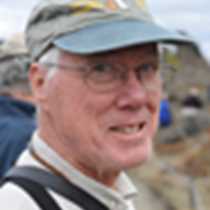Isla San Jose, the Gulf of California
During the night we moved north up the Gulf of California. We awoke off of Isla San Jose, with the morning light shining off of the volcanic mountains of the Sierra de la Giganta (the Mountains of the Giantess) on the Baja California Peninsula to the west. Layers of lava and ash tell a story of violent volcanic activity when present day Baja California was still a part of the Mexican mainland. It would have made a beautiful picture of the day, but it is not.
The high tides of the new moon allowed us access to the mangrove forest of Bahia Amortajada on Isla San Jose. Mangroves are trees that grow with their roots in salt water. They are found surrounding estuaries in warm waters all around the world. The dense stilt roots of red mangroves, in particular, trap organic sediments and provide cover for birds, larval fish, and marine invertebrates, so mangrove estuaries are an important part of the ecosystem of the Gulf of California. Fine sightings of snowy and reddish egrets, green herons, and the elusive mangrove warbler could also have provided the picture of the day, but no.
Leaving Isla San Jose we passed through a large and active group of common dolphins, leaping, cavorting, and riding the bow and the wake waves of the Sea Bird. Another fine photo opportunity, but … not! Afternoon kayaking and snorkeling at Punta Dispensa on Isla Espiritu Santo, dinner served on the beach, gazing through the ship’s spotting scopes at the rings of Saturn … more photo opportunities, but not.
No, today’s photo commemorates a walk on the desert of Isla San Jose. Tall cardon cactus; thickets of the pitaya agria cactus, whose fruits were an important food for the Indians of Baja California; the drought deciduous palo adan putting out its new leaves in response to recent rains … all large plants that grow slowly over many years, enduring the severe conditions of the desert. But there are others ways for plants to make a living in the desert. Desert annuals pass the drought conditions as seeds, germinate soon after rains, and complete the life cycle quickly before the water is gone. From a standing position you would scarcely have known that there were plants at your feet. Ah, but assume the appropriate posture, turn your binoculars around to use as a magnifying lens, and you discover that you are standing in a field of annual Euphorbia, each small plant covered with tiny but beautiful flowers, and the desert world in miniature is revealed to you.
During the night we moved north up the Gulf of California. We awoke off of Isla San Jose, with the morning light shining off of the volcanic mountains of the Sierra de la Giganta (the Mountains of the Giantess) on the Baja California Peninsula to the west. Layers of lava and ash tell a story of violent volcanic activity when present day Baja California was still a part of the Mexican mainland. It would have made a beautiful picture of the day, but it is not.
The high tides of the new moon allowed us access to the mangrove forest of Bahia Amortajada on Isla San Jose. Mangroves are trees that grow with their roots in salt water. They are found surrounding estuaries in warm waters all around the world. The dense stilt roots of red mangroves, in particular, trap organic sediments and provide cover for birds, larval fish, and marine invertebrates, so mangrove estuaries are an important part of the ecosystem of the Gulf of California. Fine sightings of snowy and reddish egrets, green herons, and the elusive mangrove warbler could also have provided the picture of the day, but no.
Leaving Isla San Jose we passed through a large and active group of common dolphins, leaping, cavorting, and riding the bow and the wake waves of the Sea Bird. Another fine photo opportunity, but … not! Afternoon kayaking and snorkeling at Punta Dispensa on Isla Espiritu Santo, dinner served on the beach, gazing through the ship’s spotting scopes at the rings of Saturn … more photo opportunities, but not.
No, today’s photo commemorates a walk on the desert of Isla San Jose. Tall cardon cactus; thickets of the pitaya agria cactus, whose fruits were an important food for the Indians of Baja California; the drought deciduous palo adan putting out its new leaves in response to recent rains … all large plants that grow slowly over many years, enduring the severe conditions of the desert. But there are others ways for plants to make a living in the desert. Desert annuals pass the drought conditions as seeds, germinate soon after rains, and complete the life cycle quickly before the water is gone. From a standing position you would scarcely have known that there were plants at your feet. Ah, but assume the appropriate posture, turn your binoculars around to use as a magnifying lens, and you discover that you are standing in a field of annual Euphorbia, each small plant covered with tiny but beautiful flowers, and the desert world in miniature is revealed to you.




